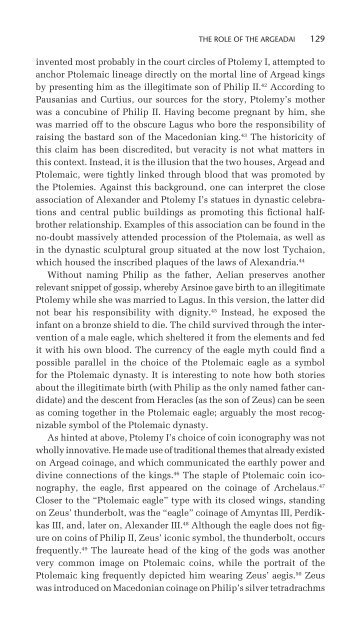Philip II and Alexander the Great: Father and Son ... - Historia Antigua
Philip II and Alexander the Great: Father and Son ... - Historia Antigua
Philip II and Alexander the Great: Father and Son ... - Historia Antigua
You also want an ePaper? Increase the reach of your titles
YUMPU automatically turns print PDFs into web optimized ePapers that Google loves.
THE ROLE OF THE ARGEADAI 129<br />
invented most probably in <strong>the</strong> court circles of Ptolemy I, attempted to<br />
anchor Ptolemaic lineage directly on <strong>the</strong> mortal line of Argead kings<br />
by presenting him as <strong>the</strong> illegitimate son of <strong>Philip</strong> <strong>II</strong>. 42 According to<br />
Pausanias <strong>and</strong> Curtius, our sources for <strong>the</strong> story, Ptolemy’s mo<strong>the</strong>r<br />
was a concubine of <strong>Philip</strong> <strong>II</strong>. Having become pregnant by him, she<br />
was married off to <strong>the</strong> obscure Lagus who bore <strong>the</strong> responsibility of<br />
raising <strong>the</strong> bastard son of <strong>the</strong> Macedonian king. 43 The historicity of<br />
this claim has been discredited, but veracity is not what matters in<br />
this context. Instead, it is <strong>the</strong> illusion that <strong>the</strong> two houses, Argead <strong>and</strong><br />
Ptolemaic, were tightly linked through blood that was promoted by<br />
<strong>the</strong> Ptolemies. Against this background, one can interpret <strong>the</strong> close<br />
association of Alex<strong>and</strong>er <strong>and</strong> Ptolemy I’s statues in dynastic celebrations<br />
<strong>and</strong> central public buildings as promoting this fi ctional halfbro<strong>the</strong>r<br />
relationship. Examples of this association can be found in <strong>the</strong><br />
no-doubt massively attended procession of <strong>the</strong> Ptolemaia, as well as<br />
in <strong>the</strong> dynastic sculptural group situated at <strong>the</strong> now lost Tychaion,<br />
which housed <strong>the</strong> inscribed plaques of <strong>the</strong> laws of Alex<strong>and</strong>ria. 44<br />
Without naming <strong>Philip</strong> as <strong>the</strong> fa<strong>the</strong>r, Aelian preserves ano<strong>the</strong>r<br />
relevant snippet of gossip, whereby Arsinoe gave birth to an illegitimate<br />
Ptolemy while she was married to Lagus. In this version, <strong>the</strong> latter did<br />
not bear his responsibility with dignity. 45 Instead, he exposed <strong>the</strong><br />
infant on a bronze shield to die. The child survived through <strong>the</strong> intervention<br />
of a male eagle, which sheltered it from <strong>the</strong> elements <strong>and</strong> fed<br />
it with his own blood. The currency of <strong>the</strong> eagle myth could fi nd a<br />
possible parallel in <strong>the</strong> choice of <strong>the</strong> Ptolemaic eagle as a symbol<br />
for <strong>the</strong> Ptolemaic dynasty. It is interesting to note how both stories<br />
about <strong>the</strong> illegitimate birth (with <strong>Philip</strong> as <strong>the</strong> only named fa<strong>the</strong>r c<strong>and</strong>idate)<br />
<strong>and</strong> <strong>the</strong> descent from Heracles (as <strong>the</strong> son of Zeus) can be seen<br />
as coming toge<strong>the</strong>r in <strong>the</strong> Ptolemaic eagle; arguably <strong>the</strong> most recognizable<br />
symbol of <strong>the</strong> Ptolemaic dynasty.<br />
As hinted at above, Ptolemy I’s choice of coin iconography was not<br />
wholly innovative. He made use of traditional <strong>the</strong>mes that already existed<br />
on Argead coinage, <strong>and</strong> which communicated <strong>the</strong> earthly power <strong>and</strong><br />
divine connections of <strong>the</strong> kings. 46 The staple of Ptolemaic coin iconography,<br />
<strong>the</strong> eagle, fi rst appeared on <strong>the</strong> coinage of Archelaus. 47<br />
Closer to <strong>the</strong> “Ptolemaic eagle” type with its closed wings, st<strong>and</strong>ing<br />
on Zeus’ thunderbolt, was <strong>the</strong> “eagle” coinage of Amyntas <strong>II</strong>I, Perdikkas<br />
<strong>II</strong>I, <strong>and</strong>, later on, Alex<strong>and</strong>er <strong>II</strong>I. 48 Although <strong>the</strong> eagle does not fi gure<br />
on coins of <strong>Philip</strong> <strong>II</strong>, Zeus’ iconic symbol, <strong>the</strong> thunderbolt, occurs<br />
frequently. 49 The laureate head of <strong>the</strong> king of <strong>the</strong> gods was ano<strong>the</strong>r<br />
very common image on Ptolemaic coins, while <strong>the</strong> portrait of <strong>the</strong><br />
Ptolemaic king frequently depicted him wearing Zeus’ aegis. 50 Zeus<br />
was introduced on Macedonian coinage on <strong>Philip</strong>’s silver tetradrachms

















